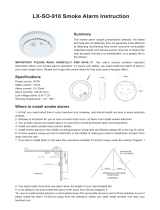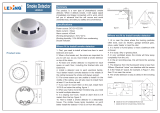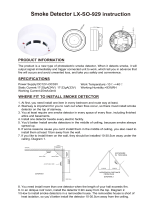Page is loading ...

LX98A-D / LX98A / LX98B / LX98C / LX98D
Smoke Alarm Instruction
LX98D
LX98A-D
LX98B
LX98C
75mm
18mm
75mm
18mm
63mm
50mm
Ø133.mm
Ø133mm
Ø133mm
Ø133mm
46mm
41mm
18mm
75mm
18mm
75mm
LX98A
Ø133mm
46mm 18mm
75mm

DC power: Power: DC9V
Static current: <10uA
Alarm current: <12mA
Low voltage alarm: 6.5V~7.5V
AC power: Power: 100-130VAC
220-240VAC
Alarm >85 db (3m) Working temperature: -10 ~50°C
1. At first, you need install them in your bedroom and routeway, and should install one item in
every bedroom at least.
2. Stairway is important for you to rush out when fires occur, so there must install smoke
detectors.
3. You at least require one smoke alarm on every floor,including finished attics and basements.
4. Install one alarm beside every electric facility.
5. Install smoke alarms in the middle of ceiling,because smog,heat and flashes always lift to the
top of rooms.
6. If some reasons cause you can’t install them in the middle of ceiling,you need to install them
at least 10cm away from the wall.
7. If you like to install them on the wall, they should be installed 10-30.5cm away under the
ceiling. Diagram 1.
8. You need install more than one alarm when the length of your hall exceeds 9m.
9. In an ablique roof room,install the alarm 0.9m away from the top.Diagram 2.
10. How to install smoke alarms in a removable house.The removable house is short of heat
isolation, so you’d better install the alarm 10-30.5cm away from the ceiling.for safety you need
install another one near your bedroom, too.
Summary
The product is photoelectric smoke alarm, it is generally more effective at detecting smoldering
fires which smolder for hours before bursting into flame.Sources of it fires may include cigarettes
burning in couches or bedding. It accords with the ISO/DIS 12239 Standard.
IMPORTANT! PLEASE READ CAREFULLY AND KEEP IT.
This user’s manual contains important information about your smoke alarm’s operation. To
insure your safety, you need install one alarm at least in your every single room. Please don’t
open the smoke alarm for that may cause improper effect. If you are installing this smoke alarm
for use by others, you must leave this manual –or a copy of it—with the end user.
Specifications
Where fit to install smoke alarm
volume:
BEST HERE
CEILING
10CM(4'')
30.5CM(12'')
SIDE WALL
MAXIMUM
ACCEPTABLE HERE
NEVER HERE
MINIMUM
MINIMUM
10CM(4'')
DIAGRAM 1
IN THIS AREA
0.9M(3ft)0.9M(3ft)
FROM PEAK
HORIZONTAL DISTANCE
ANYWGERE
DIAGRAM 2
Power frequency: 50/60Hz
Static power consumption:0.5W

BEDROOM
BASEWENT
KITCHEN BEDROOM
SMOKE ALARM FOR ADDITIONAL PROTECTION
BEDROOM
SMOKE ALARM FOR MINIMUM PROTECTION
LIVING ROOM
BEDROOM
LIVINGROOM
BEDROOM
SINGLE FLOOR PLAN
MULTIPLE FLOOR PLAN
KITCHEN
BEDROOM
Where not fit to install smoke alarm
1. Where combustion particles are produced. Combustion particles form when something burns.
Avoid installing in the areas include poorly ventilated kitchens,garages,and furnace rooms.Keep
units at least 6m from the sources of combustion particles(stove,furnace,water heater,space
heater)if possible.Ventilate these areas as much as possible.
2. In air streams near kitchens.Air currents can draw cooking smoke into the sensing chamber of a
smoke alarm near the kitchen.
3. In very damp,humid or steamy areas,or directly near bathrooms whith showers.Keep units at least
3m away from showers saunas,dishwhashers,etc.
4. Where the temperatures are regularly below 40 F(4 C)or above 100F(38 C),including unheated
buildings,outdoor rooms,porches,or unfinished attics or basements.
5. In very dusty,dirty,or greasy areas.Don’t install a smoke alarm directly over the stove or
range.Clean a laundry room unit frequently to keep it free of dust or lint.
6. Near fresh air vents,ceiling fans,or in very drafty areas.Drafts can blow smoke away from the
unit,preventing it from reaching the sensing chamber.
7. In insect infested areas.Insects can clog openings to the sensing chamber and cause unwanted
alarms.
8. Less than 305mm away from fluorescent lights.Electrical “noise” can interfere with the sensor.
9. In “dead air” space, for example,in Diagram 1,near the corner less than 10cm.
10. If you have a smoking meeting room, don’t install the alarm there for the unit will alarm when
several persons smoke.
How to install this smoke alarm
Tools you will need:
*Pencil *Drill with 6.5mm drill bit *Standard/Flathead screwdriver *Hammer
1. Hold base firmly and push the hinge in then turn anti-clockwise,so release the base down.
2. Hold the smoke alarm base against the ceiling(or wall) and make a mark at the center of each of
the mounting slots with a pencil.
3. Place the unit where it won’t get covered with dust when you drill the mounting holes.
4. Using a 6.5mm drill bit,drill a hole through each pencil mark into 35mm deep.
5. Insert the plastic screw anchors into the holes and tap them gently with a hammer.Tighten the
3*30 screws into the screw anchors,then loosen them two turns.
6. Slide the smoke alarm base up to the screw heads end up in the narrow ends of the mounting
slots, then tighten the screws completely.
7. Insert the 9V battery into the the box, make sure the red pry is under the battery,so the battery is
stable. Diagram 3.
8. Ensure to insert battery before you install the alarm,or you will destroy the unit.
9. Close the cover with the alarm according to Diagram 4,and then finish your installation.

DIAGRAM 3
9Vbattery
9Vbattery
+
-
+
-
DIAGRAM 4
PUSH
It is important to test this unit weekly to make sure it is working properly. Don’t open the alarms by
yourself, return them to the seller if improperly, and don’t use fire to test your alarms.
Test
1. Press and hold the test button on the cover of the unit until the alarm sounds. If it does not alarm,
make sure that the unit is receiving power and test it again. If it still does not alarm, replace it
immediately or check your battery.
2. The signal flashes once 30 seconds and while it alarms the signal will flash once 0.5 second.
3. If the alarm makes low “chirp” sounds every about 30seconds,it tells you to exchange your battery.
4. Little smoke will not cause alarms, so misinformation occurs only when you blow smoke to the
alarms directly or you forget to turn on your ventilated facility while your cooking.
5. Sometimes when you smoke the unit will alarm, so you can just blow air to it to stop alarming.
Regular maintenance
1. Never use water, cleaners or solvents to clean your smoke alarm since they may damage the unit.
2. Test it at least once a week.
3. Clean the smoke alarm at least once a month. Gently vacuum off any dust using your household
vacuum’s soft brush attachment. Open the cover and disconnect the battery, gently vacuum the
inside of the cover and the sensor chamber, reconnect the battery.close the smoke alarm and
vacuum the outside of the cover, test the smoke alarm.
4. Use these batteries to replace the old one.
Carbon zinc:EVEREADY 216 OR 2122;GOLDPEAK 1604P OR 1604S
Alkaline:EVEREADY 522 DURACELL MN1604 MS1604;GOLDPEAK 1604A
Lithium: ULTRALIFE U9VL
5. You’d better use good battery to make the alarm work long, some batteries can usemore than 1
year.

Limitations of smoke alarm
1. United States NFPA72 tells that the safety of life is to be noticed by alarms before fire, to confirm
the correct escape way. The fire systems help half of residents escape and we should help the old
people, women and children more because they are always the victims.
2. Smoke alarms are not foolproof, they can’t prevent or extinguish fires,they are not a substitute for
property or life insurance.You need buy some fire fighting facilities.
3. Sometimes the smoke is blocked by objects and can’t reach the detector, and if the wind blows
the smoke away from the detector, the unit won’t work either.
How to do in case of fire
1. Call the Fire Department immediately after confirming the fire.
2. Don’t panic,stay calmly and follow your family escape plan.Get out of the house as quickly as
possible,don’t’ stop to get dressed or collect anything.
3. Feel doors before opening them to see if they are hot.If a door is cool,open it slowly.Don’t open a
hot door-use an alternate escape route.
4. Cover your nose and mouth with a cloth (preferably wet). Take short, shallow breath.
5. Meet at your planned place outside your home, and do a head count to ensure everybody go out
safely.
Warning!
● Please confirm with prefessional installation.
● Please cut off power supply before installation and removal operations.
● Make sure that you have cut off the power for safety purposes.
● Improper operation caused losses, the manufacturer does not undertake any responsibility.
We are committed to promoting the product quality and reliability, however, all the electronic
components have certain probabilities to become ineffective, which will cause some
troubles.When designing, we have paid attention to redundant designs and adopted safety
quota to avoid any troubles.
This instruction, without our permission, should not be copied for any other purposes.
/







